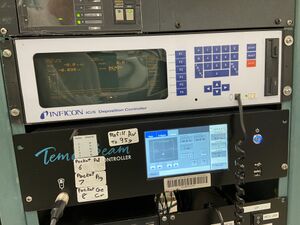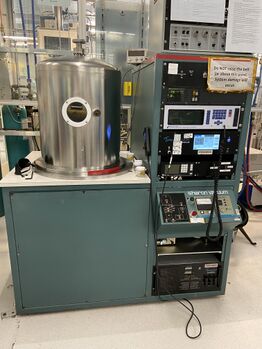E-Beam 1 (Sharon): Difference between revisions
Jump to navigation
Jump to search
Content deleted Content added
→Recipes: link to process control data |
|||
| (82 intermediate revisions by 9 users not shown) | |||
| Line 1: | Line 1: | ||
{{ |
{{tool2|{{PAGENAME}} |
||
|picture=e-beam1.jpg |
|picture=e-beam1.jpg |
||
|type = Vacuum Deposition |
|type = Vacuum Deposition |
||
|super= |
|super= Michael Barreraz |
||
|super2= Bill Millerski |
|||
|phone=(805)839-3918x210 |
|||
|phone=(805)839-7975 |
|||
|location=Bay 3 |
|location=Bay 3 |
||
|email= |
|email=mikebarreraz@ece.ucsb.edu |
||
|description = Four Pocket Electron Beam Evaporator |
|description = Four Pocket Electron Beam Evaporator |
||
|manufacturer = Sharon Vacuum Co., Inc. |
|manufacturer = Sharon Vacuum Co., Inc. |
||
|toolid=7 |
|||
|materials = |
|||
}} |
}} |
||
[[File:EBEAM1 Controls Sept2022.jpeg|thumb|EBeam#1 Deposition + Beam Controllers]] |
|||
__TOC__ |
|||
= About = |
|||
=About= |
|||
This electron-beam evaporation system is used for the controlled deposition of thin dielectric films. The films are evaporated from a wide variety of solid sources. The most common dielectrics deposited are: SiO<sub>2</sub>, SiO, TiO<sub>2</sub>, Ta<sub>2</sub>O<sub>5</sub>, SrF<sub>2</sub>. Other materials may be evaporated upon request. Oxygen gas can be bled into the system during deposition to try to maintain the stoichiometry during deposition. Fixturing for heating the substrate can also be used. A crystal thickness monitor is used to control the deposition thickness. The dielectrics deposited by this system are typically used for optical coatings (anti-reflective and highly reflective multiple layer stacks), electrical insulators, and reactive ion etching masks. Samples up to ~ 3” x 3” can be placed into this system for evaporation. Typical deposition rates are several Angstroms/second. |
|||
The Sharon is a cryo-pumped thin film evaporator with a Telemark 8 pocket electron beam evaporation source. Fixturing in EBeam1 will accept any size sample up to 4-inch diameter. In addition, a rotation fixture is easily installed which permits adjustable angle, 360° rotation of any size sample, up to 4-inch diameter. This feature is particularly useful for promoting step coverage of irregular surfaces. |
|||
EBeam1 is used for the evaporation of high purity metals, e.a. Al, Au, Ni, Ge, AuGe, Ti, Pt etc., for interconnect and ohmic contact metallization for fabrication of III-V compound semiconductor and silicon device fabrication. |
|||
=Processes= |
|||
'''This section will outline the basic processes that run on the tool.'''<br> |
|||
==Process #1== |
|||
Nam in odio quis turpis interdum dignissim ac sed dui. Nunc in lorem purus, et scelerisque velit. Maecenas at eros mauris. Donec adipiscing tristique fringilla. Nullam eu quam id ipsum luctus bibendum. Morbi ac luctus justo. Integer vitae ante ac lacus consectetur iaculis. Aliquam adipiscing faucibus fringilla. Duis bibendum scelerisque nulla vel vulputate. Fusce varius molestie pharetra. Cras suscipit sodales velit, id tempor erat fringilla eget. Pellentesque sollicitudin interdum dolor et condimentum. Donec malesuada accumsan eros ut semper. Fusce sollicitudin, sapien id ullamcorper euismod, eros augue tincidunt risus, sed venenatis turpis lacus ut elit. Sed eu sollicitudin mi. Mauris eget est eu ligula vulputate congue non et leo. |
|||
==Process #2== |
|||
Proin ut turpis lorem, eu scelerisque elit. Duis ullamcorper sem quis velit mattis in molestie justo pellentesque. Maecenas semper, quam nec posuere tempus, orci nisi pellentesque nulla, eu fringilla felis massa non nisi. Integer sit amet enim et nulla accumsan aliquet. Cras vitae aliquam risus. Aenean dapibus risus sed nunc pharetra hendrerit suscipit sem interdum. Cras feugiat cursus diam, non varius odio fermentum ac. Nulla nec rutrum augue. Aliquam pellentesque orci eget libero auctor imperdiet. Vivamus scelerisque porta tincidunt. Vivamus adipiscing ultricies porttitor. Quisque viverra dolor in nisl tempor et lacinia nulla euismod. |
|||
=Materials Table= |
|||
{| class="wikitable" style="font-size: 95%;" border="1" style="border: 1px solid #D0E7FF; background-color:#ffffff; text-align:center; font-size: 95%" |
|||
|-bgcolor=#D0E7FF |
|||
!align=center bgcolor=#D0E7FF width="75"|'''Material''' |
|||
!align=center bgcolor=#D0E7FF width="75"|'''Position''' |
|||
!align=center bgcolor=#D0E7FF width="75"|'''Hearth / Crucible''' |
|||
!align=center bgcolor=#D0E7FF width="85"|'''Film Number''' |
|||
!align=center bgcolor=#D0E7FF width="75"|'''Density''' |
|||
!align=center bgcolor=#D0E7FF width="75"|'''Z Ratio''' |
|||
!align=center bgcolor=#D0E7FF width="75"|'''Tooling''' |
|||
!align=center bgcolor=#D0E7FF width="500"|'''Comments''' |
|||
|- |
|||
|Ag||4||C||5||10.5||0.524||140|| |
|||
|- |
|||
| Al||2||C||6||2.7||1.080||118|| |
|||
|- |
|||
| Al<sub>2</sub>O<sub>3</sub>||1||C||6||3.97||0.50||169|| |
|||
|- |
|||
| Au||4||C||4||19.3||0.381||138||Bazookas can be used at 20-30Å/sec. |
|||
|- |
|||
| AuGe||3||C||5||17.63||0.397||151||Composition unpredictable unless you practically empty the crucible. |
|||
|- |
|||
| Cr||3||H||6||7.2||0.305||140||Do not evaporate more than 200Å of Cr in the E-Beam evaporator. |
|||
|- |
|||
| Fe||||||||7.86||0.349|||| |
|||
|- |
|||
| Ge||3||C||6||5.35||0.516||130|| |
|||
|- |
|||
| MgO||1||||6|||||||| |
|||
|- |
|||
| Mo||||||||10.2||0.257|||| |
|||
|- |
|||
| Ni||1||H||1||8.91||0.331||140||Prone to spitting. Cool down for 15 minutes before venting. |
|||
|- |
|||
| NiCr||1||H||6||8.23||0.321|||| |
|||
|- |
|||
| Nb||4||C||6||8.57||0.516||||Cool down for at least 35 minutes before venting. |
|||
|- |
|||
| Pd||1||H||9||12.0||0.357||140|| |
|||
|- |
|||
| Pt||1||C||8||21.40||0.245||140||Prone to spitting. Evaporate at 1.5Å/sec or less. |
|||
|- |
|||
| Si||2||H||2||2.32||0.712||150||Cool down very slowly after evaporating lest you crack the source. |
|||
|- |
|||
| SiO||||C||6||2.13||0.87||132|| |
|||
|- |
|||
| SiO<sub>2</sub>||1||C||6||2.2||1.07||140||Please change the crystal and the upper mirror after evaporating oxide. |
|||
|- |
|||
| SrF||1||C||6||4.28||0.727||140|| |
|||
|- |
|||
| Ta||1||H||6||16.6||0.262||||Requires extremely high current. Minimum 35 minute cool down. Hearth #3 may be used. Call me before you try Ta. |
|||
|- |
|||
| W||1||C||6||19.3||0.163||138|| |
|||
|- |
|||
| Ti||3||H||3||4.50||0.628||139|| |
|||
|} |
|||
=Detailed Specifications= |
=Detailed Specifications= |
||
'''Details about the tool''' |
|||
* Cryopump: CTI Cryotorr 8F with air-cooled compressor |
|||
* Pumping speed: 4,000 l/sec. for H2O, 1,500 l/sec. for air, 2,200 l/sec. for H2, 200 l/sec. for Ar |
|||
* Mechanical Pump: Varian, Model SD700, 35 CFM |
|||
* Electron Beam Source: Temescal, Model STIH-270-2MB, four 15 cc hearths |
|||
* Electron Beam Power Supply: Temescal, Model CV8A-111, -5 to -10 kV dc, 0.8A dc max. beam current; XYS-8 Sweep Control |
|||
* Deposition Control: Inficon IC 6000, 6 film programs; 37 parameters for automatic or manual deposition control based on a resonating quartz crystal sensor |
|||
* Ion Source: Commonwealth Scientific Corp., MOD. 2. Kaufman-type, 3cm ion source; beam currents to 100mA at 1000eV |
|||
*Cryopump: CTI Cryotorr 8F with air-cooled compressor |
|||
=See Also= |
|||
*Pumping speed: 4,000 l/sec. for H2O, 1,500 l/sec. for air, 2,200 l/sec. for H2, 200 l/sec. for Ar |
|||
'''Links to documents pertaining to the tool...''' |
|||
*Mechanical Pump: Ebara EV-A10, 35 CFM |
|||
* [http://www.google.com Article about E-beam Deposition...] |
|||
*Electron Beam Source: Temescal, Model STIH-270-2MB, four 15 cc hearths |
|||
* [http://www.google.com Research from other university...] |
|||
*Electron Beam Power Supply: Temescal, Model CV-6SLX, 0 - 10 kV dc, 0–600 mA dc beam current; TemEBeam Sweep Control |
|||
* etc. |
|||
*Deposition Control: : Inficon IC/5, 6 film programs; 37 parameters for automatic or manual deposition control based on a resonating quartz crystal sensor |
|||
*Pieces up to Four - 4" wafers in one run. |
|||
*For single wafers: tilt with motorized rotation and sample lowering for higher effective rates, sidewall coverage, angled evaporation. |
|||
=Documentation= |
=Documentation= |
||
*[[media:ID 2501 Ion-Beam Drive - User Manual.pdf|ID 2501 Ion-Beam Drive - User Manual]] |
|||
*[ |
*[https://wiki.nanofab.ucsb.edu/w/images/f/f0/EB-1_operation_instructions_6-6-24.pdf EBeam 1 Operating Procedure] |
||
**Operating Instructions |
|||
[[category:Vacuum Deposition]] |
|||
**[https://wiki.nanofab.ucsb.edu/w/images/a/a1/EB1_Rotation_Fixture_SOP_5-16-25.pdf Rotation Fixture SOP] |
|||
**[[E-Beam 1 - 4-inch, 4-wafer Fixture SOP|4-inch, 4-wafer Fixture SOP]] |
|||
=Recipes= |
|||
*See the [[E-Beam_Evaporation_Recipes#Materials_Table_(E-Beam #1)|'''<u>E-Beam Recipe Page</u>''']], for the materials tables and deposition parameters for various materials. |
|||
*[[Process Group - Process Control Data#E-Beam 1 (Sharon) - Process Control|'''Process Control Data''']] - Calibration data for the most utilized metals on this sytem. |
|||
Latest revision as of 18:35, 21 May 2025
| ||||||||||||||||||||||||||||||

About
The Sharon is a cryo-pumped thin film evaporator with a Telemark 8 pocket electron beam evaporation source. Fixturing in EBeam1 will accept any size sample up to 4-inch diameter. In addition, a rotation fixture is easily installed which permits adjustable angle, 360° rotation of any size sample, up to 4-inch diameter. This feature is particularly useful for promoting step coverage of irregular surfaces.
EBeam1 is used for the evaporation of high purity metals, e.a. Al, Au, Ni, Ge, AuGe, Ti, Pt etc., for interconnect and ohmic contact metallization for fabrication of III-V compound semiconductor and silicon device fabrication.
Detailed Specifications
- Cryopump: CTI Cryotorr 8F with air-cooled compressor
- Pumping speed: 4,000 l/sec. for H2O, 1,500 l/sec. for air, 2,200 l/sec. for H2, 200 l/sec. for Ar
- Mechanical Pump: Ebara EV-A10, 35 CFM
- Electron Beam Source: Temescal, Model STIH-270-2MB, four 15 cc hearths
- Electron Beam Power Supply: Temescal, Model CV-6SLX, 0 - 10 kV dc, 0–600 mA dc beam current; TemEBeam Sweep Control
- Deposition Control: : Inficon IC/5, 6 film programs; 37 parameters for automatic or manual deposition control based on a resonating quartz crystal sensor
- Pieces up to Four - 4" wafers in one run.
- For single wafers: tilt with motorized rotation and sample lowering for higher effective rates, sidewall coverage, angled evaporation.
Documentation
- EBeam 1 Operating Procedure
- Operating Instructions
- Rotation Fixture SOP
- 4-inch, 4-wafer Fixture SOP
Recipes
- See the E-Beam Recipe Page, for the materials tables and deposition parameters for various materials.
- Process Control Data - Calibration data for the most utilized metals on this sytem.
